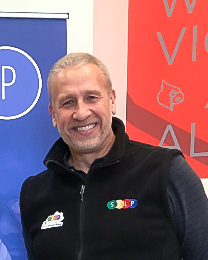
David Couch
By David Couch
Chief Information Officer, Kentucky Department of Education
When I was asked to write a column about the state of technology in the Commonwealth’s public schools, I had just one question. How much space do I have?
As anyone who knows me knows all too well, I am justifiably proud of how far Kentucky has come with education technology. We are a pioneer and national leader in both digital access and cloud computing.
All of our K-12 district offices and schools have access to high-quality fibered internet services. In fact, Kentucky originally connected all of our K-12 public school districts to the Internet in 1995 (not by dial-up) and became the very first state in America to establish this opportunity. It only took us 11 months to do that for all 176 K-12 school districts and no state has ever come close to doing that statewide faster or better. Today, Kentucky remains a national leader in being recognized for providing the most reliable and highest quality high-speed access for all of our public-school teachers and students.
Twenty-five years ago the internet and technology were still in their infancy. It was a nice addition to be able to offer your students, but it wasn’t a crucial element of any child’s education. That cannot be said today. We believe that anywhere, anytime, always on digital access to learning is not only today’s expectation, but it also is a great equalizer for all students to achieve at high levels.
We now have more than 700,000 computing devices in the Kentucky K-12 public schools and are rapidly approaching a 1-to-1 ratio of students to computers. These digital devices aren’t just window dressing; they are a vital part of each child’s learning experiences.
For example, 93% of our school districts say their students are taking online or virtual courses, which gives our students access to a wider variety of classes and experts than their parents had when they were in school. According to a 2019 survey conducted by the Kentucky Department of Education, 81% of our students find it easy to collaborate using online documents, 72% say they read content online at least once a week and 70% say it’s easy to edit a photo and those confidence levels continue to increase every year.
These are the types of skills that are in high demand in the workplace today. If our students are not learning new concepts and skills through the uses of new technologies which prepares them for a workplace that also is heavily technology dependent, then we are not giving them a good run at a successful future.
But there are many other reasons for Kentucky to be proud of technology in its schools.
In 1994, we became the first state in the nation to provide a spotlight for students using technology to learn or help their school or community by establishing the Student Technology Leadership Program (STLP). Each year more than 60,000 students from nearly 80% of our school districts from across Kentucky grow their knowledge and their sense of service by creating innovative projects and participating in regional and statewide events. This is a true demonstration of learning powered by education technology.
In 2010 Kentucky established itself as a national leader in cloud-computing by migrating all student, teacher and staff email services to the cloud. This successful implementation triggered a domino effect with our statewide student information system and statewide financial management application following suit.
2011 was a big year for education technology in Kentucky. That was the year we launched Infinite Campus parent and student portal, an app that gives parents and students access in real-time to assignments, grades and attendance information. KDE still struggles with getting parents to realize this tool is available, but I believe it is one of the best ways for families to understand what is happening in their child’s life at school.
Also in 2011 Kentucky launched the Digital Driver’s License for Digital Citizenship. In partnership with the University of Kentucky’s Digital Learning Design Lab, this app helps students learn at any grade level about such important things as cybersecurity, phishing and copyrights. While not required by districts, the Digital Driver’s License provides our students with the tools that are necessary to navigate in a world that is increasingly digital. In fact, Kentucky was the first state to create a Digital Driver’s License, which schools from 49 other states have since adopted.
In 2012, we launched the first online School Report Card to make it easier for parents and communities to find data about Kentucky’s schools. We were recognized nationally by the Education Commission of the States as one of only eight states at that time with report cards that were accessible, informative and easily understood. The tradition continued early in 2019 when the new and easier-to-read School Report Card launched.
In 2014, Kentucky was recognized nationally by the Data Quality Campaign as one of the top three states in the nation for best practices in collecting and using educational data to improve student achievement.
In 2018, we successfully field tested online testing for almost 98,000 students in 169 school districts that included assessments in biology, Algebra II and English II in grades 9-12. That was a total of almost 132,000 testing sessions, which was a massive test of our technological capabilities, while also celebrating how comfortable students were performing online.
This year more than 400,000 students in 100% of our school districts will participate in a variety of online assessments. Leveraging education technology for this experience will continue to help teachers and school leaders gauge performances and learning more efficiently.
That same year we entered into a new partnership with Kentucky Educational Television (KET) and PBS to bring more than 100,000 standards-aligned video resources to school districts across the state at no charge.
And just last year, the Kentucky Board of Education adopted the first Kentucky Academic Standards for Computer Science, which helps redefine computer science education in the state and helps ensure all students receive a high-quality education in this vital segment of our industry and future workforce.
There are many more accomplishments that the partnership between the KDE and school districts have achieved, together, that are highlighted in the KETS Master Plan for Education Technology, available on the KDE website.
We have much to be proud of over the past 25 years. Rest assured that as technology, the workplace and the world change, KDE will be working tirelessly to make sure that the Commonwealth’s children are ready for what lies ahead.


Leave A Comment